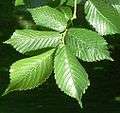Ulmus 'Lobel'
Ulmus 'Lobel' is a Dutch hybrid cultivar raised at the Dorschkamp Research Institute for Forestry & Landscape Planning, Wageningen, from a crossing of clone '202' ('Exoniensis' × U. wallichiana) with '336' ('Bea Schwarz', selfed). 'Lobel' was cloned in 1962 and released for sale in 1973.
| Ulmus 'Lobel' | |
|---|---|
'Lobel' elms, East Street, Brighton, UK. | |
| Genus | Ulmus |
| Hybrid parentage | '202' ('Exoniensis' × U. wallichiana) × '336' ('Bea Schwarz' selfed) |
| Cultivar | 'Lobel' |
| Origin | Wageningen, Netherlands |
Description
'Lobel' is a fastigiate, small-crowned, tree not unlike the pyramidal Hornbeam Carpinus betulus 'Fastigiata'.[1][2] The typically acuminate leaves are < 11 cm long × < 7 cm broad, and notably late to flush, rarely before mid-May.[3][4]
 Bark of 35-year-old 'Lobel'
Bark of 35-year-old 'Lobel' 'Lobel' leaves
'Lobel' leaves
Pests and diseases
'Lobel' was rated 4 out of 5 ("good") in the Netherlands for its resistance to Dutch elm disease.[5] However, in trials conducted by the Istituto per la Protezione delle Piante, Italy, 'Lobel' suffered 50% defoliation and 35.5% dieback when inoculated with unnaturally high concentrations of the fungal pathogen, compared with 2.8% and 1.2% resp. for 'Sapporo Autumn Gold'.[6]
Owing to the U. wallichiana in its ancestry, young specimens of 'Lobel' proved particularly susceptible to elm yellows (phloem necrosis) in trials in Italy.[7]
Cultivation
Following the development and release of cultivars such as 'Columella' more resistant to Dutch elm disease, planting is no longer recommended wherever the disease is prevalent.[8] Sales in the Netherlands declined from over 12,000 in 1989 to 1,100 in 2004.[9]
However, 'Lobel' is particularly resistant to sea winds, and was accordingly planted in large numbers in the coastal provinces in The Netherlands and by Portsmouth City Council in the late 1980s, notably to replace the Huntingdon Elms lost in the Great Storm of 1987 along the Ladies' Mile on Southsea Common. There are also large plantings at Ealing and Primrose Hill, London, Brighton & Hove, and Havant. 'Lobel' was included in trials in Canberra, Australia, started in 1988 but has not thrived in that environment.
'Lobel' was introduced to North America in 1991 when Heybroek donated material to the North Central Regional PI Station, Iowa State University, but the tree is not known to have been commercially released there.[10]
- 'Lobel', Bruns nurseries, Bad Zwischenahn
 Wind-pruned avenue of 'Lobel', Southsea, UK
Wind-pruned avenue of 'Lobel', Southsea, UK
Etymology
The tree is named for Matthias de L'obel, the Flemish botanist also commemorated by the genus Lobelia.
Accessions
North America
- North Central Regional PI Station Arboretum, ARS, Iowa State University, Ames, US. Acc. no. Ames 24988
Europe
- Arboretum de La Petite Loiterie , Monthodon, France. No details available
- Brighton & Hove City Council, UK. NCCPG Elm Collection.
- Grange Farm Arboretum , Sutton St. James, Spalding, Lincs., UK. Acc. no. 821.
- Royal Botanic Gardens Kew, UK. Acc. no. 1980.729
- Wijdemeren City Council, Netherlands. Elm collection; 't Jagerspaadje (2010) and ‘s-Gravelandsevaartweg (2016) Loosdrecht; Trapgans (2007), Ankeveen.
References
- Heybroek, Hans M. (1983). Burdekin, D.A. (ed.). "Resistant elms for Europe" (PDF). Forestry Commission Bulletin (Research on Dutch elm disease in Europe). London: HMSO (60): 108–113.
- Heybroek, H.M. (1993). "The Dutch Elm Breeding Program". In Sticklen, Mariam B.; Sherald, James L. (eds.). Dutch Elm Disease Research. New York, USA: Springer-Verlag. pp. 16–25. ISBN 978-1-4615-6874-2. Retrieved 26 October 2017.
- Santini, A., Fagnani, A., Ferrini, F., Ghelardini, L., & Mittempergher, L. (2005). Variation among Italian and French elm clones in their response to Ophiostoma novo-ulmi inoculation. Forest Pathology, 25 (2005), 183-193, Blackwell Verlag, Berlin
- Photographs of 'Lobel' elm, leaves and samarae
- Heybroek, H. M., Goudzwaard, L, Kaljee, H. (2009). Iep of olm, karakterboom van de Lage Landen (:Elm, a tree with character of the Low Countries). KNNV, Uitgeverij. ISBN 9789050112819
- Santini, A, et al. (2002). 'San Zanobi' and 'Plinio' Elm trees. HortScience 37(7): 1139–1141, 2002.
- Mittempergher, L., (2000). Elm Yellows in Europe. In: The Elms, Conservation and Disease Management. 103–119. Dunn C.P., ed. Kluwer Academic Press Publishers, Boston, USA.
- Burdekin, D.A.; Rushforth, K.D. (November 1996). Revised by J.F. Webber. "Elms resistant to Dutch elm disease" (PDF). Arboriculture Research Note. Alice Holt Lodge, Farnham: Arboricultural Advisory & Information Service. 2/96: 1–9. ISSN 1362-5128. Retrieved 26 October 2017.
- Hiemstra, J.A.; et al. (2007). Belang en toekomst van de iep in Nederland [Importance and future of the elm in the Netherlands]. Wageningen, Netherlands: Praktijkonderzoek Plant & Omgeving B.V. Retrieved 26 October 2017.
- Gibbs, J. N., Brasier, C. M., McNabb Jnr., H.S., and Heybroek, H. M. (1975). Further studies on the pathenogenicity in Ceratocystis ulmi. Europ. Journ. Forest. Path. 5 (3): 161–174.